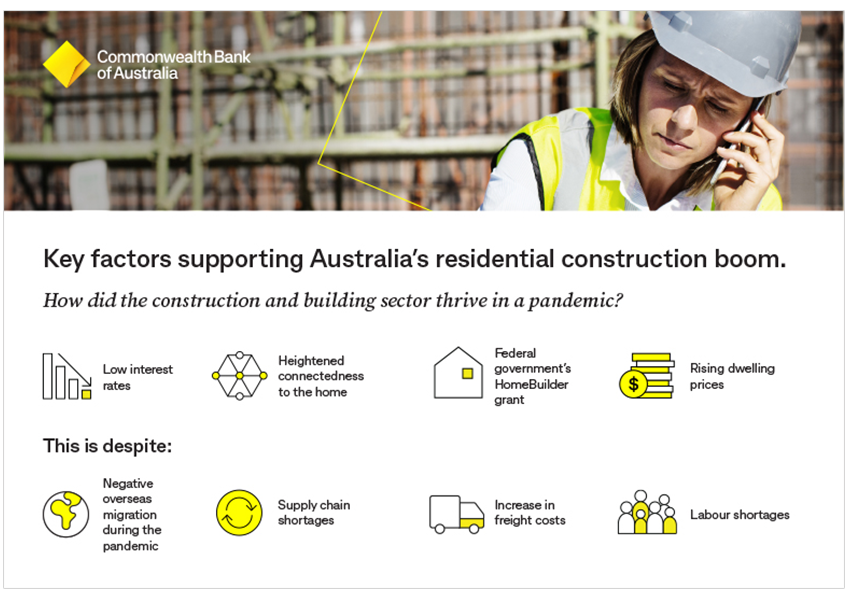Economic outlook looks strong
Despite the boom, ongoing challenges remain as disruptions to global supply chains and labour availability will drive up costs and slow down activity.
As New South Wales and Victoria begin to re-open, all eyes are turning to Australia’s economic recovery. Aird said the states had been through an extraordinary negative shock over the past four months, as spending fell almost 20% and employment fell by a combined total of about 350,000.
Interestingly, CommBank internal household data shows that income has grown fastest in states that have been in lockdown as government support payments more than offset lost wages and salaries through workers being stood down. “That bodes very well for what type of recovery we can get,” said Aird.
Household savings have soared during COVID-19 to levels not seen before. By the end of Q4 FY22, CommBank economists predict savings will be $230bn higher than normal. Add to that strong consumer confidence and low job security fears, and conditions are ripe for a spending surge that will underpin a strong economic recovery.
Supply chain issues across the sector and shifting operating models
That’s good news for companies such as Bunnings, CSR, Metricon and GWA Group that, like many of their peers, had to pivot their business models during the pandemic.
Metricon Director and General Manager of Victorian Housing, Peter Langfelder, said the pandemic forced the business to accelerate an operational change – expanding its online offering as customers couldn’t browse display homes or selection studios. But, he said, the number one challenge was construction delays due to supply issues, increased labour and materials costs, and a reduced workforce permitted on building sites.
Bunnings said keeping a step ahead of supply constraints and accelerating ecommerce ranked among its biggest challenges while GWA Group Chief Financial Officer, Patrick Gibson, said ensuring continuity of supply remains a huge obstacle and his team has worked with long-term suppliers to ensure good availability of product.
“For us it hasn’t been a capacity shortage, it’s been disruption in freight and international availability of containers. Typically, from us ordering a product to receiving it would be about 12 weeks. Today that supply chain is 20 weeks-plus,” Gibson said. “We’ve had to take actions to order much earlier, to increase safety stocks and work on substituting products.”
Bunnings’ Schneider said a variety of raw materials were impacted, including technology – items such as microchips play a big role in smart home products and power tools.
“This is where long-term relationships with suppliers and partners is really important. You can make more significant investment in working capital to be able to get inventory that you need and sit on reserve stock to meet the demand of customers,” he said.
“But this is a challenge we’ll face for some time and it’s highlighted opportunities for reform and productivity improvement in port operations … in Australia and New Zealand.”
CommBank’s Managing Director – Industrials, Transport and Consumer, Jake Potgieter, hosted the event and noted that the supply chain challenges experienced by the building and construction industry could also be seen in other industries. Most of the Bank’s institutional clients across the supply chain moved strategically and early to build inventory in order to mitigate supply risk.
Elevated inventory levels require additional funding, although most clients have emerged well through the pandemic with strong levels of liquidity. However, the Bank is working with its clients to look for efficient and cost effective funding options to optimise liquidity and working capital.
Rising labour costs will be the next wave of pressure
David Fallu, Chief Financial Officer at CSR, said the construction sector was moving from managing Covid complexity as an emergency management skill to one that was becoming business as usual and the question now was how the three historical industry drivers – interest rates, employment and population – would continue to be impacted by pandemic and non-pandemic related factors.
Langfelder said land sales, a precursor to construction, have been at record levels and construction starts have been pushed out from 12 to 18 months.
He predicted labour costs would be the next wave of pressure, as restrictions on net overseas migration has created a shortage of skilled trades. Metricon typically experiences a cost increase of 2% to 3% for materials and labour but is forecasting closer to twice that over the next year. State government-led major public works programs will also drive up labour and materials costs.
For GWA Group, total freight costs will rise about 50% this year. Commodity prices are also rising – copper and nickel are at all-time highs – and items such as plastic pipes are up 25%. Those costs will flow through to builders in six to nine months’ time.
None of this bodes well for containing surging house prices and so the focus turns to interest rates. CommBank predicts the cash rate will rise in Q2 of 2023 and Aird said even a modest rate rise of 1.25% would have a material impact on the economy.


